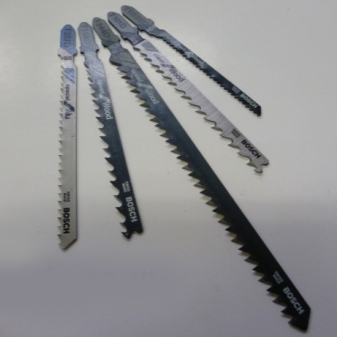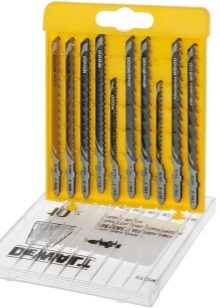Jigsaw saws for wood: characteristics and selection

In the school curriculum in labor lessons for boys, classes with jigsaws are provided. And not in vain - for someone they will be useful in adult life for daily professional work, someone will use this tool in the garage to perform minor manual work. Another thing is that for most consumers, the choice of only the jigsaw itself seems really important, while few people go into the details of the choice of saws. Many believe that all saws are divided only into those for metal and wood, however, even the latter suggest a much more ramified classification.


Peculiarities
The difference in saws for a jigsaw for wood is due to the fact that the material being sawn (although it can be conventionally called wood) can be different in thickness and density. In this case, the slightest characteristics are important, since even the angle of inclination of the teeth must take into account the structure of the selected material. The wrong choice often causes additional problems, because the process can unexpectedly drag on for a long time (this is surprising to many, but even metal saws can find it difficult to cut wood).
The sheet of material itself may suffer, not to mention the completely obvious mistake when the saw simply does not fit your model of the tool.
The seeming solution may be the universal files popular on the market.however, experts argue that this is more of a marketing ploy. According to professionals, due to the difference in the structure of individual materials, there simply cannot be a saw that would cut any workpiece equally well, and therefore a gullible buyer should not listen to such unfair advertising.


Marking
A dishonest seller can never deceive you if you are well versed in markings, because all the necessary information about the canvas is encrypted in an alphanumeric set, which is necessarily applied to it. In most cases, the marking consists of Latin letters and numbers - let's try to figure out what they mean.
- The first letter is the jigsaw shank type. It depends on this indicator whether the blade will fit your jigsaw. The most popular products are T-shaped and X-shaped shank saws, in the marking of which the corresponding letter is in the first place, less often there is also U. Ask which shank your jigsaw has, otherwise even a good file will be useless.

- The numbers are the length of the canvas. There are four main size classes: standard (75mm in length), medium (90mm), elongated (150mm) and long (over 150mm). The marking does not indicate the length of the saw in full - numbers from one to four are assigned to these classes, the first number in the marking indicates exactly the length.
- Again the letter is the dimensions of the teeth. They can be either very large (D) or very small (A). If you need some kind of intermediate position, pay attention to B (closer to small ones) and C (closer to large ones).


- Another letter is the specificity of the application of the canvas in question. This letter may not be in the marking at all, but its presence further clarifies the purpose of the product. For example, X indicates the possibility of universal use of the saw (although this will not give an ideal result in any case), and O indicates the purpose for cutting with curved turns.Blades with a P at the end of the marking are thicker and suitable for oblique cutting, with R - designed specifically for very thin and delaminating materials, while F indicates increased blade strength.
There is also a separate marking indicating the material from which the canvas is made, because this factor also matters.
For soft woods, HSC saws are usually used (steel with a high carbon content, the best solution for wood in general), for harder ones - HM / TC (hard alloys), BiM (bimetal) can also be used as some average solution.


Views
Understanding the markings means that you can quickly determine which file you have in your hand, but that doesn't mean you have learned to choose a product based on the material to be processed. At the same time, the classification of canvases is quite extensive, which always leaves room for error in choosing. To avoid wasting money, consider how certain characteristics of the saw affect the scope of its application.

To size
Unlike the same metal sheets, wood materials are rarely thin: for example, the thickness of the board can easily exceed one centimeter. For a successful cut, a significant margin of length is required, allowing the blade to walk up and down, so it is not surprising that jigsaw files for wood are usually quite long. Accordingly, the thicker the lumber, the longer the saw itself should be - up to 150 mm or more. Another thing is that the length, in one way or another, is related to the thickness.

At the same time, thick boards of fiberboard and chipboard can be roughly cut with a thick blade, but for curly cutting, a saw as thin as possible is needed, which excludes the possibility of damage to the pattern.
It is for this reason that slightly shorter specimens are usually chosen for fine work, but when cutting heavy slabs, they will work slowly and quickly wear out.


By material
Above, we have only in general terms considered the main materials from which the canvases are made (in the context of marking). Now let's take a closer look at them - with an indication of how well they suit a tree.
- Carbon Steel (HCS Marking) it is not distinguished by the highest strength, but good elasticity, for which it is rightly called the best solution for cutting wood. It is it that is considered to be a universal material for woodworking, since it "takes" everything: fresh wood, fiberboard or chipboard, and plywood, and if necessary, even plastic will succumb to it. In addition, it is sold everywhere, therefore, when you first experiment with a jigsaw or in the process of your usual work, you should not look for something else.

- Hardened Steel (HSS) suitable for wood is much worse - despite the increased strength, this material cannot boast of elasticity, and therefore it simply bogs down in dense wood. Such saws are better suited for relatively soft metals, they can only be used for soft wood and only when there is no alternative.

- Bimetallic blades (BiM) combine the best qualities of the two above - they are both very strong and elastic at the same time, they are often made with diamond plating. Another thing is that such a saw can cost significantly more, while something more modest would be enough for wood. Typically, these webs are produced for tough alloys and dense metals. Although there are special saws for wood, experienced craftsmen usually dislike them for their low productivity.
- Carbide blades (HM) their structure is optimal for tiles and ceramics. For wood processing, they are used quite rarely and more often, nevertheless, in the absence of an alternative, although in some situations they can really turn out to be a worthy option.


By the teeth
This criterion has the greatest impact on the finished cut, determining its beauty and accuracy.It may take a beginner time to learn to distinguish between different tooth patterns, but over time, he will learn to determine a suitable canvas by its appearance, without resorting to any markings.
- Milling set teeth are one of the most popular solutions, they are suitable both for various types of wood (meaning solid wood) and polymers or non-ferrous metals. As a result, the cut turns out to be rather coarse and thick, but the productivity is at the highest level, therefore this is the optimal solution for cutting blanks.
- Milling wavy teeth They are distinguished by uniformity of arrangement and some smoothness, they are well suited for cutting pressed panels from laminated wood, as well as non-ferrous metals and steel with minor impurities of carbon. Such a canvas will provide a much thinner and straighter cut.
- Set teeth with grinding are distinguished by the fact that they are directed, as it were, to the sides of the main direction. They can handle both soft and hard woods at high speeds, but the kerf can be quite large.
- Free angle ground teeth, are designed for any wood, as well as for many types of polymers. The advantage of choosing in favor of just such a blade will be the high accuracy of the cut, which makes it possible not to additionally process the edges of the workpiece.


On the tail
The types of shank have already been described above, it remains to decide which option is suitable for your jigsaw. The easiest way to find out is by referring to the instructions or by carefully examining the previously used saw for attachment to the tool body. Not all manufacturers strive to achieve the versatility of their mounts, and some even provide for different mounts for different models, which makes the consumer even more confused.
Nevertheless, let's try to understand the main trends.
- T-shank is the most popular in our time, however, and it is divided into one-stop (cruciform) and two-bearing. If the former is found everywhere and is used by many models of the brands DeWalt, Bosch, Makita, Metabo and Skil, then the latter is quite rare and is found only in Bosch.



- U-shaped shank characterized by a semicircular notch at the end. Among manufacturers, only Skil and DeWalt use it, the bulk of jigsaws are sharpened for T-shaped files.
- Straight and smooth shank with X mark widely popular with brands whose names are not so well known: for example, Bort, DeFort, Hander.
- Sometimes you also come across shanks with specific round holes, but they only fit some Makita models.



If you live away from major markets, the task of finding the optimal saw can seem almost overwhelming.
Ideally, you can get away from the problem altogether if, at the stage of choosing a jigsaw, you try to choose one that is designed for the most common files with a T-shaped one-stop shank, especially since this standard is widely used by many leading manufacturers of power tools.



How to choose?
Finally, we will give some more tips on how how to choose the best saws for a jigsaw.
- If you are working on wood regularly, try to purchase a set of files at once for both manual electric and stationary tools. This will not only allow you not to be distracted in the process of work, but will also allow you to choose the best option at any time for the type of wood that you have in your hands (taking into account the specifics of performing a specific task). Separately, we note that this approach also allows you to save money, because wholesale is always cheaper.
- Carefully read the instructions for the jigsaw itself - it may give valuable pointers as to which files are best for him.When trying to find the best option, be prepared to describe in detail to the seller of the specialized store both the planned material and the equipment used. At the same time, never go to a store with zero knowledge base - seeing a newcomer, an unscrupulous seller can deceive.
- As a rule, the best solution would be to choose blades from the same manufacturer that produced the jigsaw, taking into account the fact that the shanks in different models of the manufacturer may differ. At the same time, good nail files are produced by famous brands: Makita, Bosch or DeWalt.


For more information on jigsaw blades for wood, see the video below.













The comment was sent successfully.